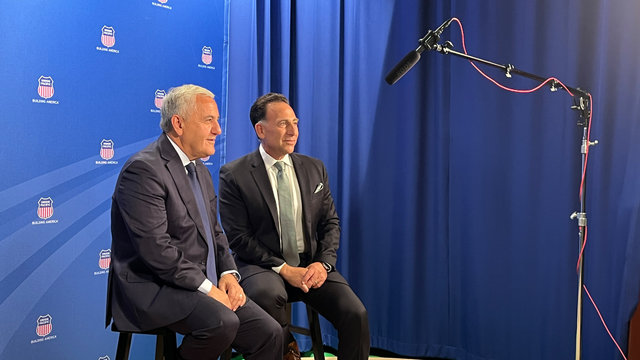
July 30, 2025
Behind the Scenes: Union Pacific CEO Jim Vena and Norfolk Southern CEO Mark George Talk Merger Benefits in Media Interviews

One question that came up several times was where did this deal originate? Did it happen over a steak dinner at a fancy restaurant?
Spoiler alert: no.
It came after a series of conversations, as the two railroad leaders talked about the future of the industry and how they could work together to grow their respective companies and the industry.
“Jim and I started talking months ago, about what we could do that was bigger than what we are doing individually, and the revenue synergies between our two companies became very clear,” George said.
Vena added: “It wasn’t a cold call. We had multiple conversations that built over time. It wasn’t ‘here’s an offer’—it was a dialogue.
On Tuesday, Union Pacific and Norfolk Southern announced they had reached a deal to create the nation’s first coast-to-coast rail network, spanning 50,000 miles and 43 states. The combination of the two companies will transform the U.S. supply chain and unleash the industrial strength of American manufacturing.
The two CEOs sat down and talked about why the time is right to merge in a series of interviews with The Associated Press, Wall Street Journal, CNBC’s Squawk Box and other trade and national publications.
Here are some excerpts from those interviews:
Q. What are some of the big benefits of the merger?
Vena: This merger is great for customers. We’ll move products faster, more efficiently, with better service. That means customers can win in the marketplace and carry less inventory. It’s also great for employees. We’re committed to preserving all unionized jobs—and we see growth, which means even more jobs.
George: As people understand what we’re proposing, they will see the benefits. For labor specifically, we’re focused on growth. Together, we can grow faster than as separate entities. That translates into more jobs.
Q. What do customers, investors and employees think of the deal?
George: When the details are absorbed by the market, they’ll understand the value we’re creating. Both companies are operating from positions of strength – we’ve got excellent safety and service records and high net promoter scores with our customers.
Vena: We’ve already had positive feedback from customers – customers who pay the bills.
Q. Are you optimistic the Surface Transportation Board (STB) will approve the merger?
Vena: We’re already operating a high-service, safe railroad, so the timing felt right. If you look at what the STB says a merger should accomplish—enhancing competition, benefiting customers and the U.S.— we’re hitting all of it.
George: We’re in a position of strength—great service, great safety, growing volumes. Our respective cultures are aligned. And more broadly, the country is going through reindustrialization. Freight demand is rising, and the administration and STB appear more open to thoughtful, growth-oriented mergers. The timing just makes sense.
Q. Will today’s news lead to other railroad mergers?
Vena: What others do is up to them. We can’t speak for the rest of the industry. For us, this was about creating a better service product, helping American industry win and moving freight more efficiently.
George: This isn’t about rail versus rail. It’s rail versus highway. We hold a relatively small share compared to trucks. We’re doing the responsible thing, moving freight to privately maintained infrastructure and off public roads.
Q. What will integration look like?
George: We’ve got two years to plan this integration. That gives us time to be thoughtful. We’re not flipping systems on day one—we’re going to do this carefully and deliberately. We’re highly motivated to avoid disruption.
Vena: We’ll also avoid rushing. We’re not forcing a strict timeline. I’ve been in rail for 47 years. I’ve seen and made my share of mistakes—we won’t repeat them.
View the SEC legend for important information about the transaction.